20-07-2020
The slummification in Verón-Punta Cana, hidden behind the all-inclusive
Marta Salvador & Giselle Cedeño | Alba SudThe Verón-Punta Cana Municipal Touristic District is characterized by a dual reality: luxury tourist resorts in front of the urban slummification of the local population, who lives in a vulnerable situation that has been intensified due to the pandemic of the COVID-19.

Photography by: Barrio Nuevo, Verón. Source: Ernest Cañada.
The Caribbean is one of the most touristic areas of the world, with a total of 31,5 million tourists in 2019, according to the Caribbean Tourism Organisation. This implies that countries of the regions, the Dominican Republic among them, are highly dependent on this economic sector. The massive tourist centres of the Caribbean have entailed changes in the landscapes, mostly in the sea-front areas with the presence of hotel complexes, in the economic activities, and in the implied societies. Therefore, in some Sea and Sand destinations that have achieved a high level of tourist development, a progression of the poverty urbanisation and an increase of the social gap have occurred.
The resultant territorial structure of the tourist urbanization has common features in the majority of Caribbean spots, with a noticeable difference in the Cuban case, as its urbanistic development presents other particularities and issues. The most significant is the growing model of the dual city: on the one hand, there is the modified strip of huge hotels and residential condominium and, on the other hand, the touristic inside formed by new residential developments where settlements appear “spontaneously”, regulated or not, and planned or without an apparent planning (González-Pérez et al., 2016). This last phenomenon, called slummification (arrabalización in Spanish), has been observed in the Verón-Punta Cana Municipal Touristic District, in the Dominican Republic. This article aims to analyse the past and present dynamics in this tourist area that have led to an informal urbanization of the population, as well as showing how the area and its residents have been and will be affected by the COVID-19 crisis.
How did tourism get to Verón-Punta Cana?
The Dominican Republic is a country mainly visited by the US and Canadian market, well- known for its beaches and its biodiversity. Moreover, it is one of the destinations with a higher increase of tourist arrivals in the last eight years (2012-2019), with a medium annual tax of growth of the 5.0%, fact that positions it as a leader of the Caribbean tourism and between the pioneer countries of Latin America. The beginning of tourism in the Dominican Republic is located in the 70s, although the final stimulus was in the decade of 1990, with the start of a frenetic implementation of the transnational hotel corporations (Isa, 2011). As a result, Sea and Sand tourist areas attracted new and intensive migrant movements, constructing cities over huge urban regions where in the past there were only rural communities or non-built-up areas (González-Pérez et al., 2016).
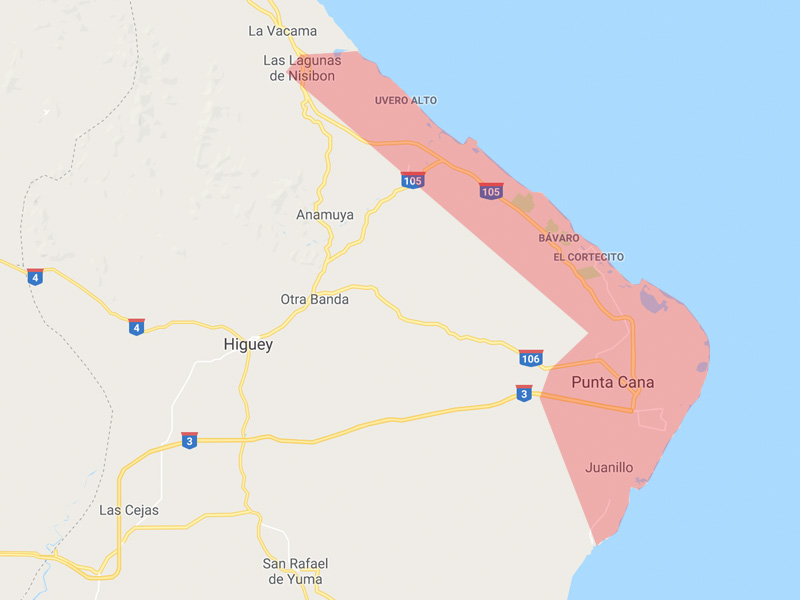
Map of the Touristic Municipal District Verón-Punta Cana. Source: Google Maps.
Verón, which is part of the city Higüey, province of La Altagracia, located in the East of the Dominican Republic, is an example of this tourist development and one of the most visited destinations of the Island and the Caribbean at this moment. Concretely, the development of the zone of Verón started in 1971 with the inauguration of a small hotel known as Punta Cana Club, with a capacity of 40 hosts. This establishment was under the direction of the Dominican Frank R. Rainieri and the North-American Theodore W. Kheel,from the Compañía de Desarrollo Turístico, Residencial e Industrial, S.A. (CODDETREISA) which nowadays is the Grupo Puntacana S.A. In 1982, the Grupo Puntacana S.A. obtained the authorization to build the first Commercial International Airport, constructed and operated by a private company. After its inauguration in 1984, international flights started to run which caused that the zone continued expanding towards Bávaro with investments of mainly Spanish companies, with chains like Barceló, Melià, River, Iberostar and Princess, that developed the all-inclusive tourist model. Therefore, from 1997 almost 20.000 new rooms were added to 32.000 in 2012 (González-Pérez et al., 2016), which have reached 37.800 in 2019.
Nowadays, the zone concentrates more than half of the hotel rooms of the country and there were expectations of growing to reach 45.000 during 2020, before the pandemic of the COVID-19, according to the declarations of Ernesto Veloz, president of the Asociación de Hoteles y Proyectos Turísticos del Este (ASOLESTE). Thanks to this development, Verón came to be the first Touristic Municipal District of the Dominican Republic in 2006. Therefore, it not only augmented demographically to attain the degree of District, but tourism was the reason for this growth. Besides, it is located at the centre of the tourist pole Macao-Punta Cana, the most important of the country, where, in accordance with the National Office of Statistics (ONE), in January and February 2020, the 47% of tourists that arrived at the Dominican Republic visited this zone.
How is the phenomenon of slummification in Verón-Punta Cana?
At the same time that hotel infrastructures were increasing, hundreds of people from other areas of the country started to displace looking for a job, which resulted in strong internal immigration. Despite this, the majority of workers came from Haiti (Blázquez et al., 2011) and, although they arrived temporarily to work on the construction of hotel infrastructures, they stayed there permanently. The result of these demographic and urbanization processes linked to tourism was the construction of an unequal, polarized and segregated city where, along with elitist spaces, today there are highly impoverished territories. In these cities, socially and structurally fragmented, exclusion prevails as a form of social and spatial organization. Thus, spaces of poverty are constructed with urban forms of variable complexity, almost always based on informality (González-Pérez et al., 2016). Ramón, who has lived in Verón for three years, explains that “people think that living here is the best. My family always tells me you earn dollars, but here you live worse and with very expensive rents. Life is much more expensive”.
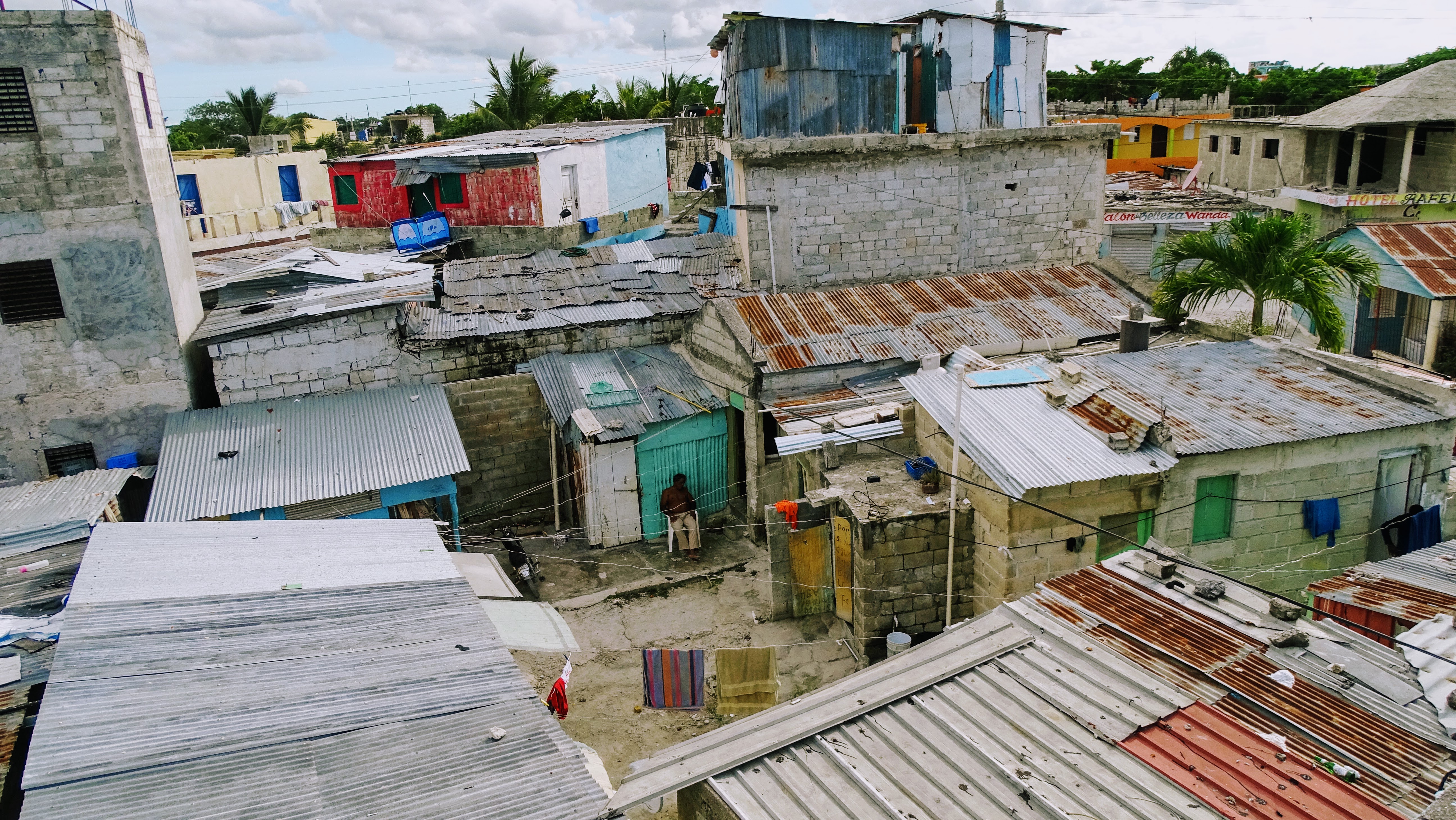
Aerial photograph of Hoyo de Friusa. Source: Ernest Cañada.
Like González-Pérez et al., (2016) state, unlike the strategies more or less planned for the touristic development and the use of land from tourist centres, under auspices of national governments and foreign multinational corporations, there are no urban planning policies for cities that must provide accommodation and services to workers in the area. Rojas (1989) expresses that improving the spatial integration of different types of human settlements requires policies that encourage public investment in transport and communications infrastructure and the promotion of efficient public transport services. Despite this, political authorities and the commercial tourist community, at least in the Dominican case, are aware of the segregation and slummification, as well as the problems that they cause, but there is no land-use plan and not even the Minister of Tourism (MITUR) has not commented on it. This is a highly idealized vision that supposes the existence of a geographic reality that operates as a group of disconnected pieces, as if the economic exit of the emergent tourist centres has anything to do with the labour situation of the working population who lives in the informal settlements (González-Pérez et al., 2016).
According to the National Office of Statistics, with the last census made in 2010, the Verón-Punta Cana Municipal Touristic District of has 54.218 inhabitants, although these numbers could be more due to the time elapsed. Ramón Ramírez, the current director of the town, confirms that the population has incremented 100%, up to 150.000 inhabitants in 2020. The human settlements experiment rapid changes as a result of the growth of the population, greater complexity of the economy, and the transformation of the land distribution structures (Rojas, 1989). Moreover, the touristic functionality of some Caribbean and Central-American territories has provoked the gentrification of the area, where rich users have certain privilege and can access to the property, the use of land and natural resources with a margination of the local population (Blázquez, Cañada & Murray, 2011).
This is the case of the Verón-Punta Cana Municipal Touristic District, which has highly slummified zones where inhabitants live in very precarious conditions: streets are in a very bad state, without pavement, they do not have garbage collection services and have to use makeshift landfills, they do not have any aqueducts or sewers, nor can they meet their basic infrastructure needs in conditions. In addition, the absence of a hospital (the nearest one is an hour and a half away) and the inability to pay for services in a clinic, further increases diseases and mortality. Another problem facing the population of Verón-Punta Cana is water pollution, as 80% of the wells are contaminated by faecal bacteria. Seferino, who has been living in the 2nd Samaritano District for 18 years, being originally from Sousa (Puerto Plata), in the North of the Dominican Republic, when asked what has changed in the community throughout this time, says that it has only varied in number: “There are many more people and houses than before, but not many improvements. For example, the streets are still unpaved, there are no sidewalks or containers, we don't even have parks”. Luisa, also a member of the Verón community, says that they need a school, as many families who live there cannot afford a private school. This is how the residents of informal settlements tend to be marginalized from the “formal” development processes of cities, which makes it difficult for them to access all kinds of opportunities, perpetuating the cycle of poverty and precariousness (Sandoval & Sarmiento, 2019).
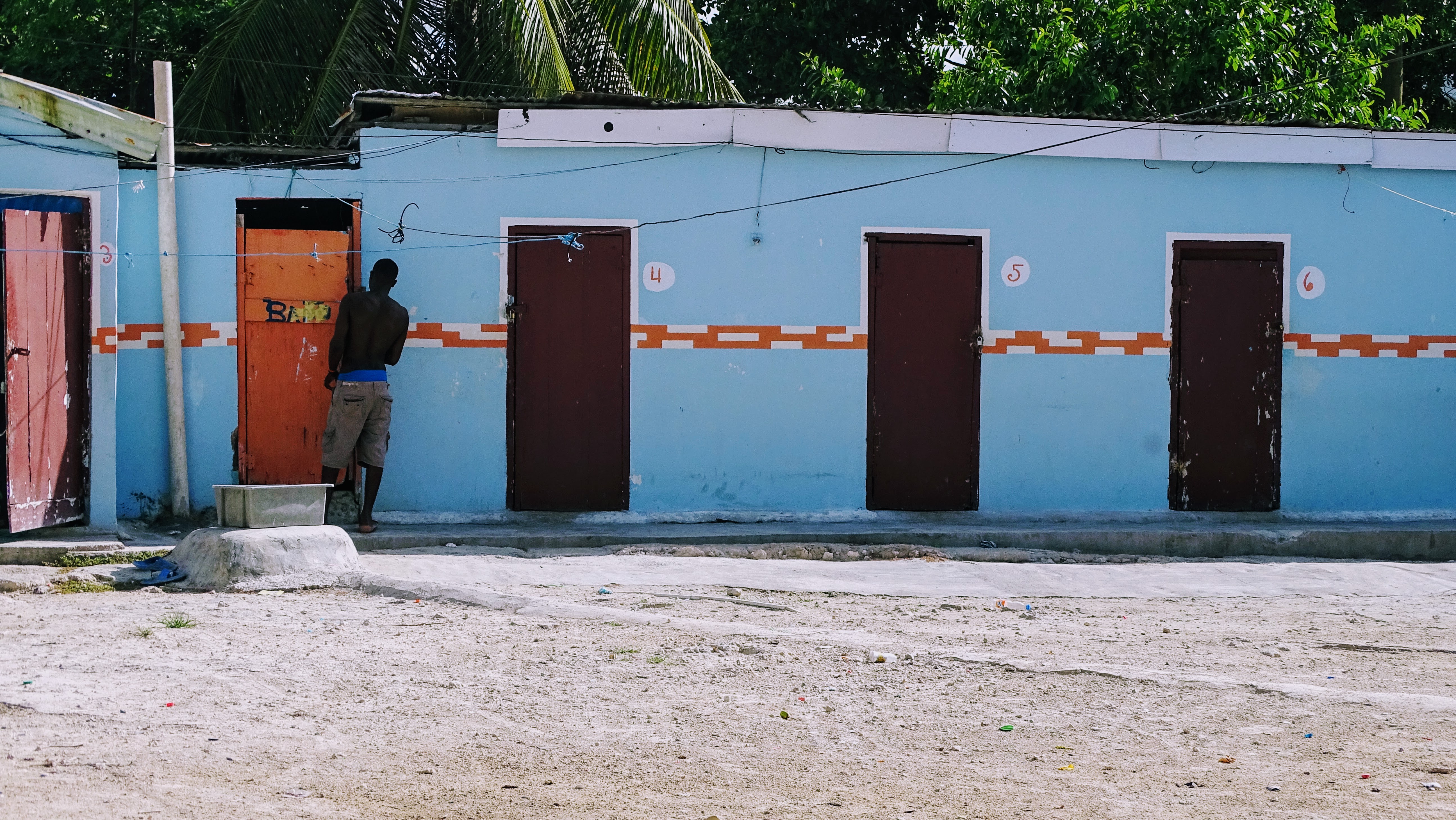
Rooms in Hoyo de Friusa. Source: Ernest Cañada.
In the neighbourhood Hoyo de Friusa, in Bávaro, one of the spots in Verón-Punta Cana, where the construction workers settled in the beginning, this situation is even more exacerbated. In this area, there is the highest migration of Haitian people, who live in a state of poverty that has led to the rise of the informal economy, but also crime, drug use and exercise of prostitution as a means of survival. Obviously, the wealth produced by the tourism business is not reflected in these neighbourhoods where a rather worrying situation is experienced. Therefore, growth and tourism specialization have not translated into an improvement in the well-being of the population, attracted to precarious jobs and vulnerable by the tourist enclaves, which recreate an unreal space of spectacle and consumerism, at a great distance from the common standards in the local community, and of the daily reality of tourists (Blázquez, Cañada, & Murray, 2011). Locals, such as Ramón, believe that neighbourhoods do not receive the benefits of tourism because in areas with informal settlements there is no offer for the tourist: “When I offer the transport service and go to the hotels, I always take them to other towns like Higüey or La Romana, as there is no commercial square or place where they can consume here”.
How has and how can affect the crisis of the COVID-19?
The arrival of the COVID-19 has intensified this fragile situation lived by locals, in an unequal community and with huge necessities. The evolution of the virus provoked that, at the end of February, flights coming from Italy were prohibited to avoid its propagation and, afterwards from Europe, China, South Korea and Iran. Finally, on March 19th, 2020, Dominican Republic was declared in the National State of Emergency, blocking the passage through all borders, which led as a result of the stoppage of the tourist activity of the whole country. In Verón-Punta Cana, the hotels closed their doors as a consequence of the distancing measures imposed by the government and the closing of tourists’ arrivals due to the blocking of aerial, terrestrial and maritime ways. Therefore, thousands of workers in the tourist sector lost their job permanently, although there is no official data of these numbers. Apart from the jobs in hotels, in Verón-Punta Cana formal and informal works are developed, which have been also affected by the COVID-19. Among them, there are people who work in souvenirs shops, tourist guides, fruit and hand-crafts street vendors, etc. This is the case of Seferino, worker of a souvenirs shop that closed in February and explains that “all this period of time I have not been working…, if it had not been for the help of friends and donations, I don’t know what might have happened”.
With the arrival of the COVID-19 families that live in slummified areas have been the most affected and the ones that have required more necessities. The low salaries of hotelier workers do not let them have the capacity of saving and the majority of people live the day-to-day. Residents of neighbourhoods like Villa Plywood, Villa Esperanza, Haití Chiquito, Hoyo de Friusa, Macao, and Uvero Alto, among others, could have survived these months thanks to the help programmes of the Government and the diary donations, from Monday to Saturday, of 30.000 food rations until June 29, by the Cuerpo Especializado de Seguridad Turística (CESTUR), in coordination with the hoteliers of Bávaro-Punta Cana, in the Verón-Punta Cana Municipal Touristic District. Also, through Grupo Puntacana S.A. which sent 300 purchases of raw food for distribution to communities. Mention should be made of workers in the construction sector, mostly Haitian immigrants, who receive a salary for the daily hours worked. Due to the illegal status and informality of their work, they have not had access to the help that the Dominican government has implemented for the most vulnerable families.
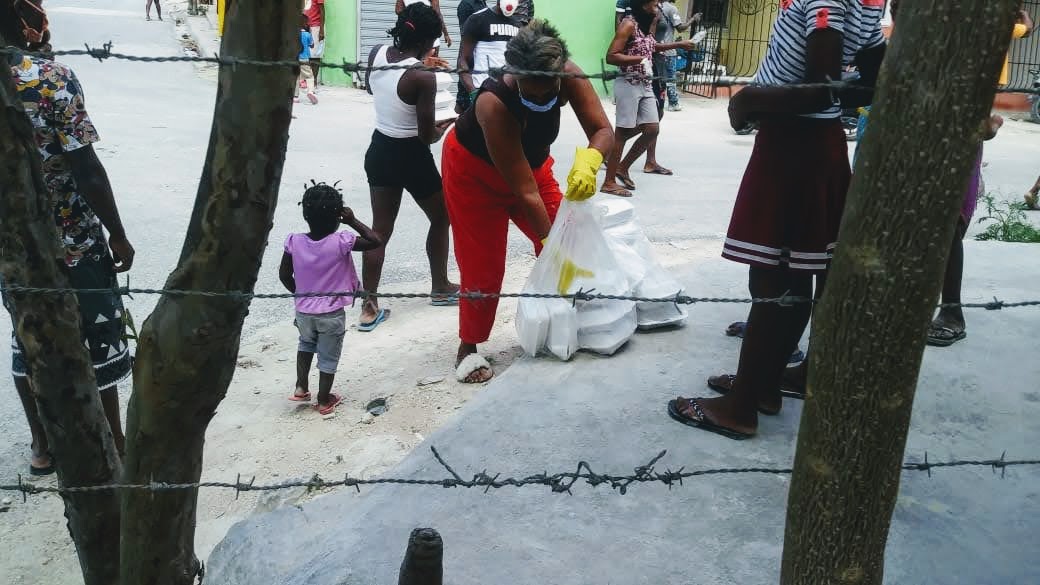
Delivered food during the pandemic of the COVID-19 in Samaritano 2do in Verón. Source: Luisa Yan.
Luisa, former president of the Board of Neighbours and president of the Adrián Community Association, an association made up of 32 women from the community who help the neediest, explains that the situation is difficult. Although the association has continued to work during the pandemic, people of Haitian nationality arrived in search of resources, to which they were able to help with what little they had. On the other hand, Luis, who worked in a water sports company and lost his job for COVID-19, comments on this: “I received cooked food from CESTUR who, with the help of some community leaders, went door-to-door to bring food”.
The recovery of the touristic activity of the zone will be done progressively and, as Elisabeth Guerrero explains in Alba Sud, there is a boost for the local tourism and, in a close future, the international market, mainly from the United States and Canada. In front of the crisis, the promotion strategy of the sector used by the Dominican Republic is based on airlines, tour operators, and the promotion of security in tourist destinations, with priority to retake charter flights, being tour operators the best allies. Therefore, job positions will be occupied as tourists keep arriving at the Touristic Municipal District, although the uncertainty about the recovery of the sector and, consequently the generated occupancy, is still present. This situation is worsened for people who could have displaced to Verón-Punta Cana, looking for a job and face this harsh reality and with precarious conditions. At the same time, there are several scenarios for what might happen: Will immigrants return to their place of origin? What will happen to those who cannot consider this option?
For Seferino, the situation has worsened, as he expresses that he cannot return to his village without anything: “Arriving and telling my daughters that I am here, empty-handed, is not an option for me. I am willing to do whatever it takes to be able to eat, even work as a painter, even if they don’t pay me much because I’m not an expert in the craft, but at least they give me for transportation, food, and 400 pesos that I get, which help in something. On the other hand, Luis comments that “due to this pandemic, I have seen many people return to their villages as they cannot even pay the rent. Help has not reached everyone and some do not have daily support. More or less the cooked food rations helped us, but that's over. "
A clear fact is that the social gap in a future post COVID-19 will continue to widen, both for locals who cannot meet their basic needs and for those who cannot find work. On the other hand, this could be an opportunity to take advantage of the slowdown in tourism in the area, where the local government could launch an action plan for proper management of Verón-Punta Cana, where the priority is given to the well-being of local communities. Thus, social protection mechanisms could be established, guaranteeing decent working conditions, with wages and benefits to be able to live properly; providing living areas in good condition, so those suburban areas are replaced by decent neighbourhoods; and, finally, paying more attention to the quality of life of communities and not to the economic growth of tourist destinations, which remains in the hands of very few.
Final reflections
Dependence and functional specialization in tourism in many Caribbean countries are current phenomena. From the social and political point of view, tourism excludes and increases segregation and precariousness in the territories, as in the Verón-Punta Cana Municipal Touristic District, in the Dominican Republic. As González-Pérez et al., (2016) state, it is a process of accumulation by dispossession in which agents in the tourism industry violently seize the resources of an excluded population and without access to the income generated. As a result, the population and urbanization growth produced by immigration has been channelled in irregular settlements, which has led to the development of a large informal economy.
The contrasts between the tourist area and the urban space that serves as accommodation for the immigrant population correspond to the dual tourist city model. On the one hand, there is a strip of sand modified by hotel complexes and residential condominiums, a high level of facilities and a lot of social exclusivity. On the other hand, the city is growing rapidly, without infrastructure and with a high social polarization, where workers are housed. However, these transformations can be explained by the fact that, although the wages received in the tourism sector are precarious and comparatively very low, they are higher than those obtained in other sectors in the local territories.
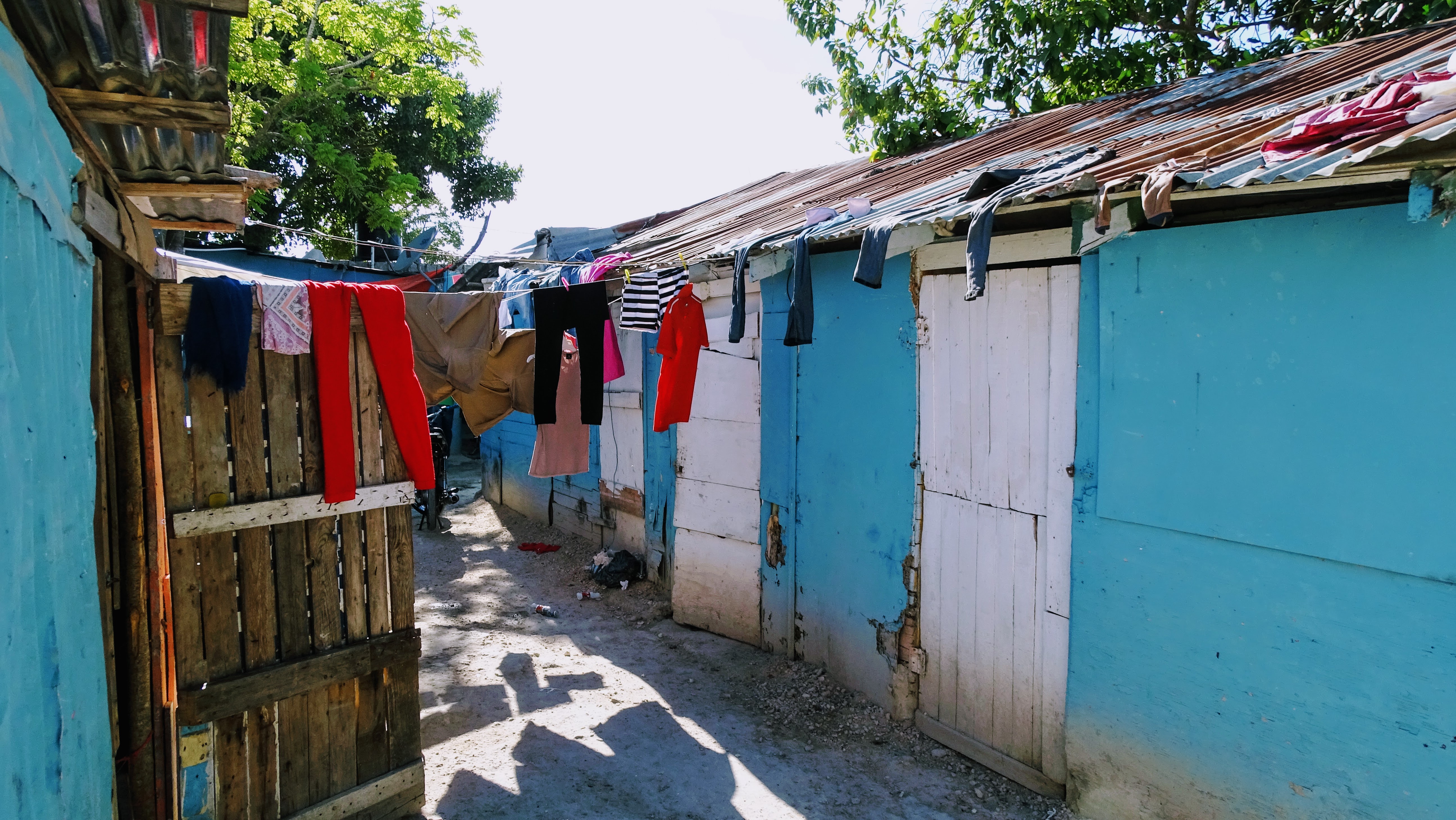
Houses in Barrio Nuevo, Verón. Source: Ernest Cañada.
To date, the level of intensification within Dominican tourism is low, mainly focused on Sun and Sand tourism and with a high dependence on all-inclusive resorts. As the case of Verón-Punta Cana shows, five-star hotels are bordering on poverty and social inequality, an issue that must go beyond small interests and politics. The territory does not yet have a National Spatial Planning Plan or the support of public services. Thus, this could be an opportunity to form the precise alliances to provide the necessary infrastructure and allow visitors to leave the resorts to explore local communities and strengthen their economy.
In addition, in the face of the arrival of the COVID-19 pandemic, local communities in excluded areas have been most affected and their situation has worsened with the loss of jobs and increased needs. The premises, highly dependent on tourist work, are faced with uncertainty about the evolution of the sector and the consequences of the crisis. That is why, as we mentioned, this moment should be the door to a future with higher quality work, protection systems for workers, and improved living conditions for all people established in the slummified areas.
